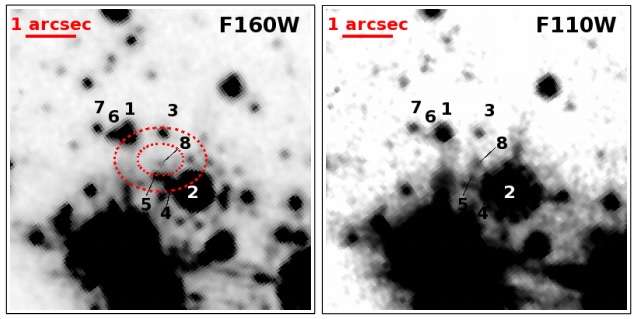October 11, 2016 report
New infrared source detected in supernova remnant RCW 103

(Phys.org)—Canadian astronomers report the discovery of a previously unseen infrared source in supernova remnant RCW 103, located some 10,000 light years away. According to a paper published Oct. 7 on arXiv.org, this newly detected source could be associated with a bright X-ray source known as 2E 1613.5-5053 and classified as a central compact object (CCO), that was discovered over 30 years ago.
RCW 103 is a 2,000-years-old supernova remnant in the constellation Norma that is bright at X-ray, radio, optical and infrared wavelengths. In 1980, using the Einstein X-ray Observatory, astronomers spotted a mysterious bright X-ray source, that was designated 2E 1613.5-5053. The nature of this source remained a puzzle for researchers for nearly 30 years. In 2008, it was classified as a CCO.
On June 22, 2016, the Burst Alert Telescope onboard NASA's Swift satellite detected a millisecond-timescale magnetar-like burst coming from 2E 1613.5-5053, and a team of astronomers led by Shriharsh Tendulkar of the McGill University in Montreal, Canada, took the opportunity to investigate the mysterious object more closely.
They used the Hubble Space Telescope's (HST) Wide Field Camera 3 (WFC3) to conduct observations of 2E 1613.5-5053 on July 4 and Aug. 11. The team found a new source that was absent in the HST observations carried out in 2002.
"We observed 2E 1613.5-5053 with the Hubble Space Telescope (WFC3/IR) and we report here on the detection of a previously unseen infrared counterpart. In observations taken on 2016 July 4 and August 11, we detect a new source (mF110W - 26.3 AB mag and mF160W - 24.2 AB mag) at the Chandra position of 2E 1613.5-5053 which was not detected in HST/NICMOS images from 2002 August 15 and October 8 to a depth of 24.5 AB mag (F110W) and 25.5 AB mag (F160W)," the researchers wrote in the paper.
The team noted that the newly detected infrared source brightened by at least 1.3 mag (F160W) when compared to the non-detections in previous observations conducted in 2002. This change in brightness allowed the scientists to assume that the new source is associated with 2E 1613.5-5053.
However, what still baffles the researchers is a 6.67-hour periodicity of 2E 1613.5-5053 with nearly 50 percent modulation in the X-ray band with no hint of faster pulsations. Tendulkar's team suspects that the infrared emission from this object may be due to an accretion disk with an orbital period of 6.67 hours. It is also possible that this emission is from the neutron star or a fallback disk where the given period is interpreted as the rotational period of the neutron star.
Future observations, especially after the next-generation James Webb Space Telescope (JWST) is launched into space and becomes operational, could reveal more insights on the real nature of this intriguing object.
"Further understanding of the nature of 2E 1613.5-5053 can be achieved via spectroscopy of the faint infrared source to search for disk emission features and whether the continuum is better described by a power law spectrum or a disk blackbody spectrum. While this is extremely challenging with current observational capabilities, it may be possible with the James Webb Space Telescope," the researchers concluded.
More information: Near Infrared Counterpart of 2E 1613.5-5053, the Central Source in Supernova Remnant RCW 103, arXiv:1610.02268 [astro-ph.HE] arxiv.org/abs/1610.02268
Abstract
On 2016 June 22, 2E 1613.5-5053, the puzzling central compact object in supernova remnant RCW 103, emitted a magnetar-like burst. Using Director's Discretionary Time, we observed 2E 1613.5-5053 with the Hubble Space Telescope (WFC3/IR) and we report here on the detection of a previously unseen infrared counterpart. In observations taken on 2016 July 4 and August 11, we detect a new source (mF110W=26.3 AB mag and mF160W=24.2 AB mag) at the Chandra position of 2E 1613.5-5053 which was not detected in HST/NICMOS images from 2002 August 15 and October 8 to a depth of 24.5 AB mag (F110W) and 25.5 AB mag (F160W). We show that these deep IR observations rule out the possibility of an accreting binary but mimic IR emission properties of magnetars and isolated neutron stars. The presence or absence of a low-mass fallback disk cannot be confirmed from our observations.
© 2016 Phys.org





















